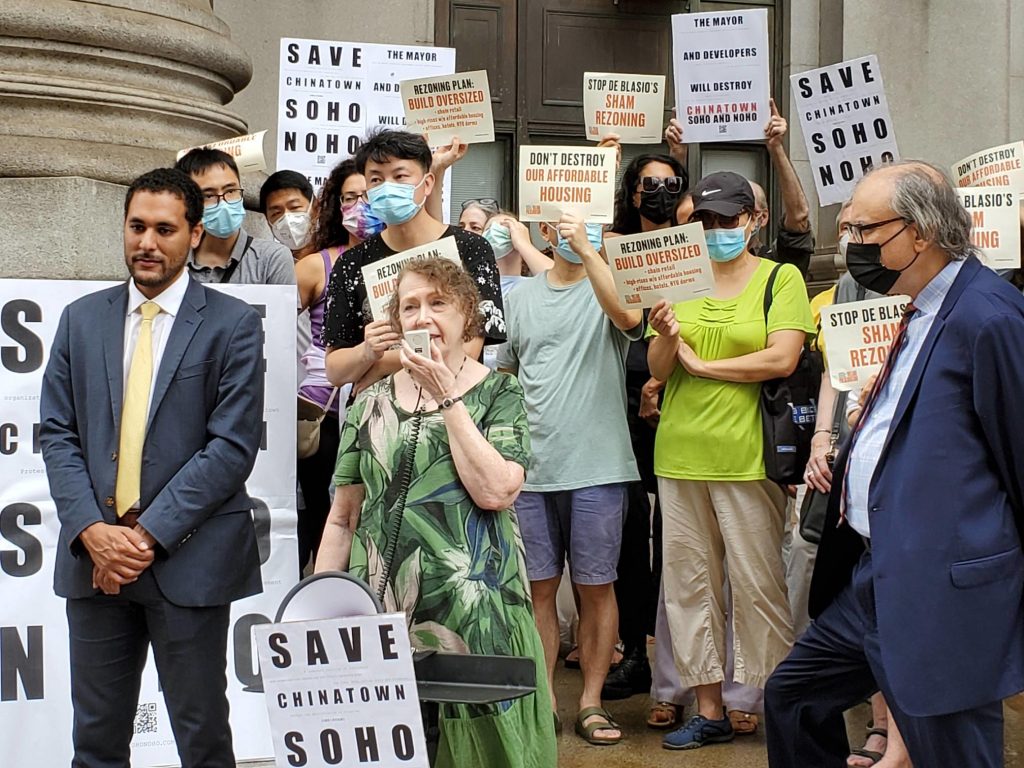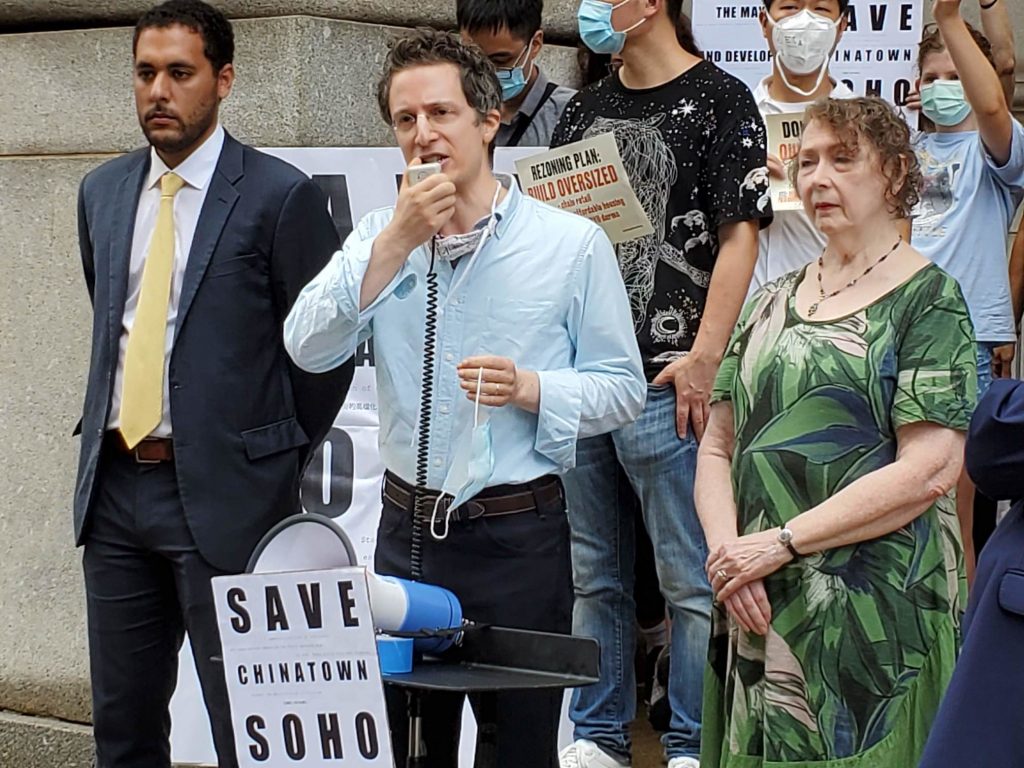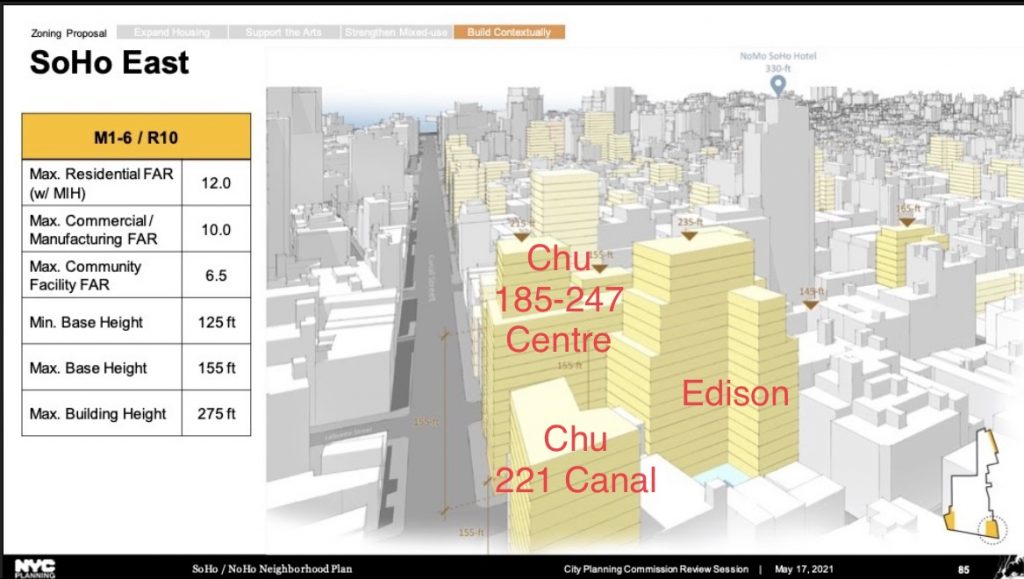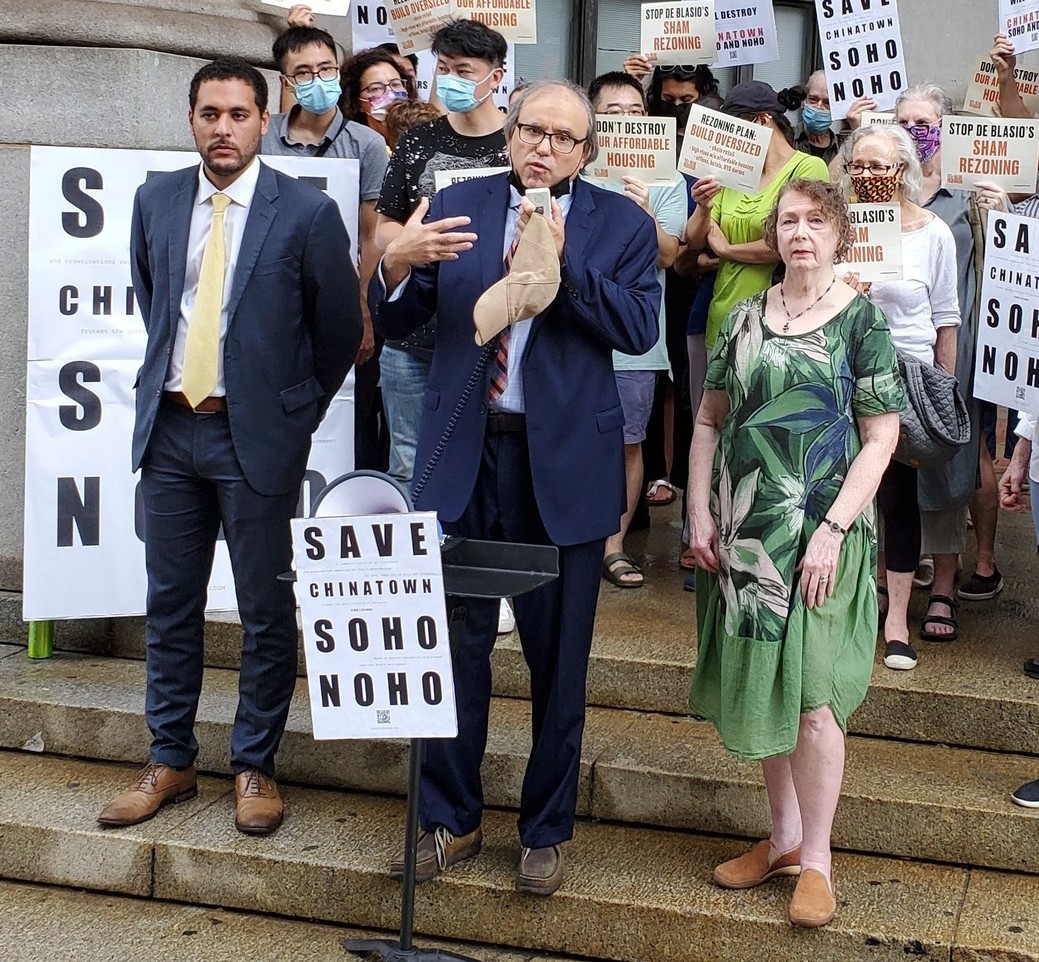BY LINCOLN ANDERSON | “Do the right thing,” the expected incoming District 1 City Councilmember and two of his predecessors urged Gale Brewer, calling on her to vote no on the Soho/Noho rezoning.
Decrying the rezoning as a “fraud” and a “sham,” Chris Marte, the district’s Democratic nominee, was joined Monday by former Councilmembers Alan Gerson and Kathryn Freed in pleading for the Manhattan borough president to back scrapping the embattled scheme.
Brewer is slated to issue her advisory recommendation on or before Thurs., Aug. 26.
The three politicos, joined by activists from Soho, Noho and Chinatown, rallied at noon outside Brewer’s office in the Dinkins Municipal Building. At 6 p.m., the B.P. was slated to hold a virtual public hearing on Zoom as part of her role in the land-use review (ULURP) for the massive rezoning proposal.
“Hundreds of people will be on the Zoom call tonight,” Marte said. “She has an option. Nothing is a done deal. Please, Gale, think of the future.
“From the start of this process, Councilmember [Margaret Chin], the mayor and the Department of City Planning have been intent on ignoring the voices of residents and neighbors of Soho, Noho and Chinatown,” Marte said. “Instead of listening to the advocacy of tenants-rights organizations and low-income tenants themselves, they’ve run a P.R. smear campaign to discredit the people they are meant to represent. No part of this community-engagement process has been genuine or in good faith, as city representatives have been condescending and rude, revealing their clear bias for luxury development, every step of the way. I hope the borough president, my future colleague in the City Council, breaks this precedent of willful ignorance and disrespect, and listens to the people of Lower Manhattan instead of deceitful talking points from special-interest groups and the Department of City Planning.”
Freed, who represented Lower Manhattan’s District 1 from 1992 to 2001, moved into Soho in 1969, though now lives on Grand St. on the Lower East Side. She recently retired as a judge, which now allows her to speak out on political issues — like the Soho/Noho rezoning.
She noted that artists colonized Soho’s empty buildings in the 1960s and ’70s simply “because they wanted to stay” and, in doing so, indirectly turned it into a chic neighborhood.
“There were acres and acres [of empty buildings],” she recalled. “They called it ‘Hell’s Hundred Acres.’
Special zoning — artist in residence, a.k.a. A.I.R., and joint live-work quarters for artists, J.L.W.Q.A. — was, in turn, created for Soho, “so the Fire Department knew people were living there,” she explained.
“The people who put their blood, sweat and tears into [fixing up the abandoned buildings] are still there,” she stressed. “Developers have been trying to find a way around the protective zoning that we put into place.
“Soho is recognized worldwide as one the most successful repurposing of outmoded and underused building stock and the creation of an immensely successful community, ever,” she said. “This is even more impressive when you consider that it was done by individuals without government help or funding. As someone who’s been part of the fights it took to create and continue this unique community, I am horrified that the city is now intending to destroy it to benefit Big Real Estate.
“Funny how once building owners were only too happy to get anyone to pay money to live in Soho,” she said. “But, as soon as Soho was successful, big developers began trying to capitalize on it. And now the city is about to give them everything they ever wanted. This is especially galling since the city has specifically avoided allowing real input from that very community that it is so intent on destroying.”

Freed was outraged at how the city and development advocates have falsely tried to paint all the residents in the proposed rezoning area as wealthy and privileged. She cited figures from research by Village Preservation that disprove those claims.
“Twenty-five percent are wealthy,” she said. “But the other 75 percent are not. You have a lot of low- and middle-income people.”
She was indignant at what she called the “blind bias that everyone who lives in Soho is rich. They aren’t!” she said.
Freed said that although the rezoning plan’s backers trumpet that it would create affordable housing, it’s nothing more than a red herring.
“This is just a development grab,” she declared. “They’ve been trying to get into this area since it became successful.”
Freed warned that the upzoning would destroy a truly unique neighborhood. She noted that distinctive cast-iron building facades like Soho’s only exist in a very few others places — including Paris and a small remnant in Chicago.
“You can’t recreate Soho,” she said. “You can’t build over it and expect it to be the same.”
The former councilmember also wondered at how part of Chinatown wound up being lumped in with the Soho/Noho rezoning area. The Chinatown part of the rezoning area is expressly earmarked as an “opportunity zone” for developers and, as a result, would see demolition and displacement of rent-regulated tenants under the plan.
“Why did they put part of Chinatown into this developmental block except that it created the possibility of making a lot of money?” Freed scoffed. “It’s going to take the eviction of a lot of people. That’s not going to be easy, but it’s been done.
“It’s an outrage to think that this is going to create more affordable housing or more diversity,” she continued. “It’s going to do exactly the opposite.”
She also likened de Blasio’s Soho/Noho rezoning to his early fiasco with Rivington House, calling it just another giveaway to developers. Freed noted that it was under her tenure in the City Council that Rivington House was converted from a former public school building into an AIDS hospice, one of the first in the city. Under de Blasio, though, the Lower East Side property stealthily was slated for luxury development — despite a deed restriction that Freed hammered out, stipulating that it must be used for health purposes, like a hospice. However, after a public outcry, the building is now being transformed into Mount Sinai Health System’s behavioral health building.

But Mount Sinai only came into the picture later on, she said, because “the optics were bad” on the residential-conversion plan.
“I just want to remind everyone that Rivington House was the first shot,” she said, adding, “I’m still pissed off about Rivington House.”
Freed also took a whack at Councilmember Chin, who supports the rezoning.
“She doesn’t give a flying f— about residents,” she said, adding, “She never saw a development she didn’t like.”
Alan J. Gerson represented the district from 2002 to 2009, but lost to Chin in his bid for a third term after Mayor Bloomberg and Council Speaker Christine Quinn extended term limits. Noting he grew up at 505 LaGuardia Place, on East Houston St., just across from Soho, he said he witnessed the neighborhood’s transformation into a vital arts enclave.
The rezoning plan would lead to displacement, he warned.
“This is not an upzoning,” he said. “This is an ‘up-and-out’ plan. We all know Lower Manhattan needs more affordable housing. This plan will result in the loss of affordable housing.”
If the upzoning is approved for Soho and Noho, it would be the first time this has ever happened to any of New York City historic districts, whose buildings are protected as landmarks.
“Make no mistake about it, this is part of a real estate stampede to do away with historic district landmarking,” Gerson cautioned. “This is a frontal assault that I take personally.
“As the most recent past councilmember for the First District — during the eight years following 9/11,” Gerson said, ” I can tell you that in the Lower Manhattan rebuilding effort, we maintained and added affordable housing, to protect lower-income residents, especially seniors, and to promote diversity, equity, affordability and livability in our neighborhoods.
“This rezoning plan does just the opposite. It would push out and threaten the homes of lower-income residents, who are disproportionately seniors and Asian American, destroy the character of these neighborhoods, specifically the unique remaining arts character, and add little if any affordable housing.
“It would add tons of big-box chain stores, high-end office buildings and hotels, and luxury condos and rentals, without any plan for environmental sustainability, green space or infrastructure,” he added. “That’s not what our city needed when I was on the City Council, and it’s not what it needs now.”
In short, Gerson said, the Soho/Noho rezoning “is an environmental, as well as a cultural and neighborhood disaster.
“Let’s go back to the drawing board,” he urged. “Let’s go back and come up with a true affordable housing plan.”
He also advocated for converting 5 World Trade Center into affordable housing.
In addition, Gerson noted that his mentor, longtime Assemblymember Bill Passannante, wrote the Loft Law. He also name-checked his own mom, Sophie Gerson, a Downtown leader who was a stalwart on the local school board. He assured that both Passannante and Sophie would have opposed the Soho/Noho rezoning.
The former councilmember also added that the rezoning “does not have community support,” in that Community Board 2 nearly unanimously rejected it.
Speaking of C.B. 2, Antony Wong, the board’s treasurer, noted that for the past 37 years he thought he had been living in Chinatown, but now, according to the Department of City Planning, it’s suddenly “Soho East” by dint of being a prime “opportunity zone” under the rezoning.

And yet, Chinatown, which is full of non-English speakers, saw barely any community outreach about the plan, he noted, calling this “disingenuous” on the city’s part. The city did outreach to commercial ground-floor tenants but not to residents, until he asked for some, he said. In the end, the city did do one outreach meeting for Chinatown residents: Only one person went, Wong’s mother, because he told her to go, he said.
Wong pointed out that the Chinatown corner of the proposed rezoning area just happens to feature prime development sites, including a number of contiguous lots owned by the Chu family, who are Chinatown powerbrokers, and also an open-air parking lot owned by Edison Properties.
“I implore the borough president to vote no [on the rezoning],” Wong said.
Juan Rivero, special projects director at Village Preservation, emceed the press conference.
“We’re deeply gratified that out future and most recent past city councilmembers see what a farce and a sham this rezoning is, and how it would do the exact opposite of what the city claims, making this a wealthier, less affordable, less equitable neighborhood,” Rivero said. “It would drive out the hundreds of remaining lower-income, rent-regulated tenants and bring in a flood of high-end chain stores, luxury office buildings, hotels and condos, and destroy the historic character of this neighborhood, all to line the pockets of the developers who have lobbied and donated generously to the mayor for this final fire-sale giveaway of city real estate.”
In addition, groups opposing the rezoning plan include TenantsPAC, Met Council on Housing, the New York City chapter of the Sierra Club, Chinatown Working Group, the National Trust for Historic Preservation and the Preservation League of New York State, among others.
More information on the rezoning plan and opposition to it can be found at villagepreservation.org/


Copy of my letter to BP Gale Brewer:
Dear Gale,
I write to express my opposition to the “up and out” zoning plan (as your former colleague in the City Council, Alan J. Gerson, masterfully defined it at a recent rally) that the Mayor intends to wreck Noho and Soho with.
This plan was concocted by corrupt politicians fronting for the real estate and construction industry with only one goal in mind: increase their profits. I don’t believe that is a sound principle in government and I urge you to reject it and the plan that is shilling for these wannabe masters of the New York Universe.
New York is the shining example of Urbanism the entire world looks up to for inspiration and imitation: Rem Koolhaas in the preface to his seminal “Delirious New York” calls it the Rosetta Stone to decode the XX century. I have ascertained its leadership in my professional life: I once served as tour guide and interpreter for the Mayor of Milan, Italy (my place of birth), on a fact-finding trip to explore urban reconversion of areas’ homes to declining industrial activities, such as Soho and Noho used to be, into fertile grounds for the development of creative communities. The results are tangible in today’s Milan, where countless projects have been developed, on empty lots, while conservation and enhancement of existing historic buildings have added value to the entire city, which I used to suffer when I visited family, but has become a pleasant destination in the last decade: I now enjoy spending time there.
One of the reasons, in my view, THE reason, of New York’s success, is its diversity, in all aspects of the city’s life: cultural, economic, legislative. All kinds of people come to New York City from all over the world (apparently, even the “original” Lenape inhabitants came from the Delaware Valley), finding a home and grounds for the development of their ideas and urban utopias. Historically, this doesn’t happen in a vacuum: Every plan has an impact, and affected communities and socioeconomic components voice their opinion and vie for input. The result, when the process of consultations is a true debate, is the “gorgeous mosaic” our city continues to be: Please do not contribute to turn it into the one-industry city our corrupt representatives intend to. The opposition to this plan in the affected communities is unanimous, and the “support” for it is nothing more than astroturfing concocted by the same developers that have bought and paid for “their” politicians, and vainly attempted to buy the last City Council primary election: The People knew better, and overwhelmingly voted for the candidate who vowed to represent their interests. And I may add: the interests of New York City as a cosmic entity. I urge you to join the tsunami of popular opposition to this crooked plan and to be on the right side of History.
If approved, this plan would allow buildings to be built to 2½ times larger than what is currently permitted. It would promote out-of-scale luxury condominiums, destroy the character of these neighborhoods, and set a dangerous precedent, threatening neighborhoods throughout the city.
Included in SoHo and NoHo are some of the city’s most popular historic districts. The plan, as it now exists, would dramatically alter the scale within those districts. It would also allow the proliferation of large chain “big box” stores, making it more difficult for small, independent and family-owned businesses to survive.
While this upzoning plan is presented as a means to promote affordable housing, the specifics of the plan belie that claim — there are no provisions for explicitly middle- and low-income residents nor for retaining existing affordable housing. The plan would result in neighborhoods that are less affordable, less neighborly and less hospitable.
Why must Chinatown, Soho and Noho be forced to accommodate and deal with developers wanting to steal ever more sunlight from us, to sell to folks who have nothing in common with the people of our neighborhoods, do so very little to add to our communities, creating null and void neighborhoods out of what have been dynamic, local and most of all FRIENDLY places to live and work?
Perhaps the city would be better off getting rid of the 15-, 20- and 25-year tax abatements these developers enjoy and pass on to unsuspecting purchasers of condos and co-ops. Better to build to reflect the median incomes of the existing neighborhoods and leave the precious scale we are able to live in and enjoy without intrusion. The builders of these oversized properties have gone out of their way to purchase properties in far-flung locations to offer to residents they are arranging to “relocate to the neighborhood”– no longer a requirement, use those same properties to transfer to the allowable square footage of towers they hope to build. Chinatown, Soho and Noho enjoy a human scale missing from anything getting built in Manhattan. Luxury buildings have been built without interference in the skyline. Properties bought decades ago are sitting awaiting developers to get this kind of intrusion put into place. The Bowery and Houston Street “hotel corridors” should give anyone pause.
There should be no reason for it, other than to create an island for the well-to-do. And to give already very wealthy individuals the means to create greater wealth at the expense of the existing residences.
The only thing all this building has produced is arid, vacant neighborhoods with no amenities, humans isolated in their towers with no connection to anyone around them, scale so large as to render their residents meaningless in the community in which they live….. UGH!